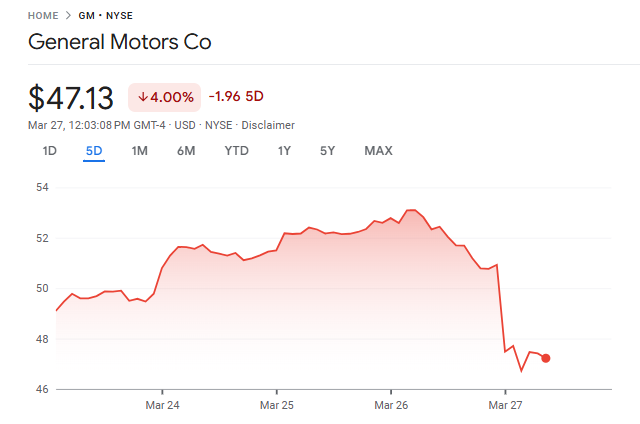On March 26, 2025, President Trump announced a 25% tariff on automobiles manufactured outside the U.S., effective April 2, 2025. The immediate aftermath? A flood of news articles predicting skyrocketing car prices, uncontrollable inflation, and economic turmoil. By the morning of March 27, as the market opened, General Motors (GM) stock plunged by over 8%, dropping from $50.93 to $46.73 in just a few hours.
This wasn’t just a natural market reaction—it was a textbook example of fear-based market manipulation. Fear sells, and fear creates opportunity for those who know how to navigate it. The steep dip in GM’s stock price? That was a buying opportunity for savvy investors.
Why GM Will Recover—and Why Some Investors Made a Fortune
- GM Is an Automotive Giant
GM is the 6th largest auto manufacturer in the world and second largest in the U.S. (behind Ford). In 2024, Ford reported $176.2 billion in revenue, while GM followed closely at $171.8 billion. These are not the numbers of a company that will crumble under pressure. - The Government Has GM’s Back
GM isn’t just any company; it’s a cornerstone of American manufacturing. The U.S. government has bailed GM out multiple times, including the historic $51 billion bailout during the 2008 financial crisis. More recently, during the pandemic, GM was among the manufacturers prioritized for federal support. The idea that the government would let GM collapse due to a tariff adjustment is unlikely. - GM Still Has a Strong U.S. Manufacturing Presence
While GM does have manufacturing operations abroad, it maintains a significant presence in the U.S. with 12 assembly plants and 24 additional facilities focused on stamping, propulsion systems, components, and battery manufacturing. This means GM is far more insulated from the tariffs than companies that rely heavily on foreign production.
Will Car Prices Really Increase? Maybe, Maybe Not.
While many predict that car prices will skyrocket due to the tariff, the reality is more complex. Pricing depends on consumer demand and supplier strategies. If demand remains high, manufacturers may pass the cost onto consumers. However, if demand falls, automakers will have to find ways to absorb costs, such as increasing domestic production or adjusting pricing strategies. The short-term impact of tariffs is always uncertain, but market forces will dictate the long-term outcome.
The Market Overreacted—And Some Investors Took Advantage
Before Trump’s tariff announcement, GM stock closed at $50.93 on March 26, 2025. By 10 AM EST on March 27, it had dropped to $46.73—a panic-induced selloff. However, those who understood GM’s fundamentals saw the opportunity. By the time of writing, GM’s stock had rebounded to $48.15, and history suggests it will likely continue recovering.

The Lesson? Fear Creates Wealth—For Those Who See Through It
Was this really bad news? Or was it just another case of the market reacting to fear-driven headlines? The key to successful investing is understanding the fundamentals of the companies you invest in. GM remains a powerhouse in the auto industry, and short-term volatility only benefits those who stay level-headed.
Don’t follow fear. Follow value. That’s where wealth is made.
Related Articles:
- What If the U.S. Matches Tariffs with the World?
- Are Tariffs Good or Bad? The Debate You Need to Know
Financial Disclaimer
The information provided on HelpyYourFinances.com is for general informational purposes only and is not intended to be financial advice. While we strive to ensure the accuracy and reliability of the content, it is important to remember that financial decisions are personal and should be tailored to your individual circumstances.
We strongly recommend that you consult with a qualified financial advisor or other professional before making any financial decisions. The content on this website should not be considered a substitute for professional financial advice, analysis, or recommendations. Any reliance you place on the information provided is strictly at your own risk.



